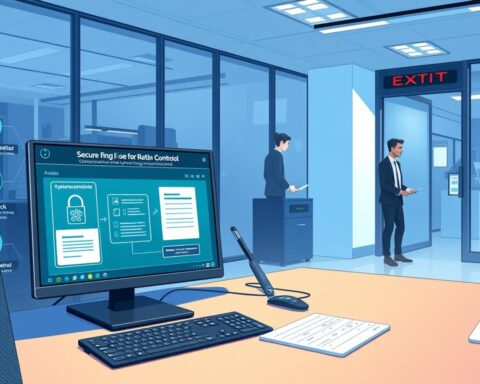Data breaches can cost companies over $4.35 million on average. Good recovery plans can cut this cost by 50% or more1. This shows how vital a solid breach response strategy is for quick recovery.
Companies with a detailed incident response plan can find and fix breaches 50% faster1. This makes fast recovery after a breach key to cybersecurity.
Keeping software up to date can stop up to 80% of known vulnerabilities from being used by hackers1. Also, encrypting backups can stop 90% of ransomware attacks, keeping data safe during breaches1. This underlines the need for a full breach response strategy.
Key Takeaways
- Having a well-planned breach response strategy is key for quick recovery after a breach
- Regular software updates can stop up to 80% of known vulnerabilities from being used by cybercriminals1
- Encrypting backups can stop 90% of ransomware attacks, keeping data safe during breaches1
- Companies with a detailed incident response plan can find and fix breaches 50% faster1
- Fast recovery after a breach is vital for less downtime and less impact from a cybersecurity incident
Understanding the Impact of a Security Breach
A security breach can severely harm an organization. It’s vital to have a data breach recovery plan ready. This plan should include quick incident response solutions to limit the breach’s damage. The average cost of a breach is $4.45 million2, and it takes 277 days to identify and contain2.
Having a plan can cut down these costs and response times. It’s key to have a breach recovery plan in place.
Security breaches can lead to lost customer trust and legal issues. They can also cause long-term damage to a company’s reputation and finances. To lessen these effects, it’s important to have services that can quickly respond to and recover from a breach. Companies that act fast save over $1 million compared to those that don’t3.
Knowing the types of security breaches and their effects is essential. This knowledge helps in creating an effective breach response strategy. It includes having a plan for incident response and procedures for notifying customers and stakeholders. By doing this, organizations can lower the risk of a breach and lessen its impact if it happens.
Organizations should also consider hiring a qualified cyber breach firm with a retainer. This can save time and money during a breach response2. They should also do tabletop exercises annually to stay up-to-date on their incident response plans2. By taking these steps, organizations can be ready to handle a security breach and reduce its effects.
Rapid Recovery After a Breach: The First 24 Hours
The first 24 hours after a breach are key for rapid incident recovery and post-breach recovery. Quick action is vital, as slow detection lets attackers do more harm. This can make the breach worse4. Companies that spot breaches fast, like those using threat intelligence, can cut the breach time by about 28 days4.
Acting fast can save a lot of money. Companies that respond in the first hour can save up to $700,0005. Breaches by third parties take about 12.8% longer to fix than internal ones4. This shows how important quick action is.
Some important steps in the first 24 hours include:
- Containing the breach to prevent further damage
- Assessing the damage to understand the scope of the breach
- Starting the recovery process, including notifying stakeholders and beginning incident response
By taking these steps, organizations can lessen the breach’s impact. This ensures a smooth post-breach recovery and rapid incident recovery5. Threat intelligence and incident response plans also help reduce breach time and losses4.
Essential Components of Your Incident Response Plan
A well-planned incident response plan is key for quick recovery after a breach. It includes team roles, communication protocols, and documentation needs. Having a breach response strategy helps organizations handle security incidents well. Studies show companies with a plan save $1.2 million on data breach costs compared to those without6.
Effective incident response solutions need a clear understanding of the incident response lifecycle. This lifecycle has key activities in different phases, helping in systematic recovery7. It includes steps like containment, eradication, and recovery, plus post-incident activities like lessons learned. A good breach recovery services plan also has a communication plan. This can speed up response times by 40%6.
Some key things to consider for an incident response plan are:
- Team roles and responsibilities
- Communication protocols
- Documentation requirements
With these components, organizations can respond quickly and effectively to security incidents. This minimizes the breach’s impact. For more on incident response planning, check outincident response planning.
| Component | Description |
|---|---|
| Team roles and responsibilities | Clearly defined roles and responsibilities for incident response team members |
| Communication protocols | Established protocols for communication during an incident |
| Documentation requirements | Requirements for documenting incident response activities |
By following these guidelines and adding breach response strategy, incident response solutions, and breach recovery services to their plan, organizations can respond quickly and effectively. This minimizes the impact of a breach7.
Digital Evidence Collection and Preservation
Collecting and keeping digital evidence is key in investigating a breach. Many organizations are not ready for a cyber attack. They need good digital evidence collection plans8. A solid data breach recovery plan and effective incident response are essential.
Good incident response needs the right resources and planning9. Keeping electronic evidence right is vital for a full view of a security issue. This means strict data preservation rules9. Important steps for digital evidence collection and preservation include:
- Secure collection and storage of evidence
- Documentation of chain of custody
- Use of forensic tools and techniques
With a strong data breach recovery plan and incident response, organizations can collect and keep evidence well. This helps a lot in investigating and recovering from a breach8.
Digital evidence collection and preservation are complex tasks. They need special skills and resources. Organizations should get help from experts and invest in good incident response solutions9.
Implementing Business Continuity Measures
It’s key to have breach recovery services ready to go. This helps businesses bounce back fast after a breach. Sadly, 40% of companies shut down for good after a disaster10. So, having a plan is super important.
Post-breach recovery is all about getting back to normal. This means fixing critical systems and data fast. Rapid incident recovery solutions help do this. Plus, training employees on cybersecurity can stop many breaches10.
Critical System Recovery
Getting critical systems back up is vital. You need to know which systems are most important and how to fix them quickly. Cloud-based disaster recovery lets teams work from anywhere, even if offices are closed10.
Data Restoration Procedures
Having a plan for data recovery is also key. This means knowing how to get data back after a disaster. Automation makes this faster, cutting downtime a lot10. It boosts team efficiency by 37% and cuts downtime by 71%11.
Stakeholder Communication Strategy
A good stakeholder communication plan is key to keeping an organization’s reputation after a breach. It includes having plans for incident response, breach recovery, and post-breach recovery. In 2021, the average cost of a data breach was $4.24 million, showing the need for clear communication to reduce financial losses.
It’s important to have good internal communications, a clear customer notification process, and strong media relations. As12 points out, talking to stakeholders during a breach can stop misinformation. A proactive communication plan can also make people see the incident management in a better light. Also13, says that being open during a data breach is key, with 75% of people wanting regular updates during crises.
Internal Communications
Having clear communication plans and roles is essential for talking to internal teams. This means setting up an incident response team and sharing updates with them without sharing sensitive information, as12 suggests.
Customer Notification Process
Telling customers about incidents quickly is important for keeping their trust. As12 mentions, giving regular updates helps keep stakeholders engaged and trusting, even after the incident. It’s also important to set realistic timelines for recovery.
Media Relations Management
Having a designated spokesperson is key to avoiding mixed messages in media talks after an incident. According to12, being consistent can boost stakeholder confidence by 25%. By using incident response, breach recovery, and post-breach recovery in the communication plan, organizations can manage stakeholder relationships well and keep trust.
Post-Breach Security Enhancement
Improving security after a breach is key to stopping future attacks and lessening their damage. It means adding new security steps and updating how you handle incidents. This ensures rapid recovery after a breach. The National Institute of Standards and Technology (NIST) and the SANS Institute say important steps include getting ready, finding the breach, stopping it, fixing it, and recovering14. A breach response strategy is needed to guide these efforts.
Some groups use tools for constant monitoring to spot network weaknesses right away15. This method helps fix vulnerabilities faster, often in 30 to 90 days15. By focusing on quick fixes and having a cybersecurity incident recovery plan, companies can lessen a breach’s effects and keep running smoothly.
It’s vital to get all parts of the business involved in the response. This ensures a full effort in breach response strategy. This includes using notification services at the end of the investigation to follow data breach laws14. By being proactive in improving security after a breach, companies can lower the chance of future attacks and bounce back quickly.

Conclusion: Building a Resilient Cybersecurity Framework
Building a strong cybersecurity framework is key to bouncing back from a breach. It should have a solid breach remediation process, good incident response, and reliable recovery services. Studies show that 96% of CEOs see cybersecurity as vital for growth and stability16. Also, the cost of a data breach for businesses is about $4.88 million in 202416.
A good incident response plan can lessen a breach’s impact. A trustworthy recovery service can also cut downtime and data loss. Companies with a cyber resilience plan can keep their business running smoothly during cyber attacks16. By focusing on breach remediation, incident response, and recovery, businesses can fight off cyber threats and grow securely.
In today’s digital world, cybersecurity is essential, not just a luxury. Businesses must put cybersecurity first and build a strong framework. This way, they can safeguard their assets, keep their business running, and keep customer trust. With the right tools in place, companies can stay safe and succeed in the digital age16.
FAQ
What is the importance of rapid recovery after a breach?
What are the different types of security breaches and their consequences?
What are the essential steps for rapid recovery after a breach in the first 24 hours?
What are the essential components of an incident response plan?
Why is digital evidence collection and preservation important?
How can business continuity measures be implemented effectively?
What is the importance of stakeholder communication after a breach?
How can post-breach security enhancement prevent future breaches?
What is the importance of building a resilient cybersecurity framework?
Source Links
- How can you prepare for data recovery after a cyber attack? – https://www.linkedin.com/advice/3/how-can-you-prepare-data-recovery-after-cyber-attack-8v1gc
- Understanding data breach response and recovery – https://www.cai.io/resources/thought-leadership/data-breach-response-plan-recovery-strategy
- Data Breach Response Times: Trends and Tips – https://www.varonis.com/blog/data-breach-response-times
- Third-Party Breach Response: 6 Immediate Actions to Take | Prevalent – https://www.prevalent.net/blog/third-party-breach-response/
- Cyber Breach Recovery Timeline: Effective Remediation – https://www.alvaka.net/crafting-a-cyber-breach-recovery-timeline-for-resilience/
- Incident Response Plan: How to Build, Examples, Template | TechTarget – https://www.techtarget.com/searchsecurity/feature/5-critical-steps-to-creating-an-effective-incident-response-plan
- 7 Proven Security Incident Response Steps For Any Breach – https://purplesec.us/learn/incident-response-steps/
- Digital Forensics Fundamentals: Successful Preservation of Evidence – https://www.ftitechnology.com/resources/blog/digital-forensics-fundamentals-successful-preservation-of-evidence
- The importance of evidence preservation in incident response | Sumo Logic – https://www.sumologic.com/blog/the-importance-of-evidence-preservation-in-incident-response/
- The Importance of a Disaster Recovery Plan for Business Continuity – Netcentrix – https://netcentrix.com/news/the-importance-of-a-disaster-recovery-plan-for-business-continuity/
- Business Continuity Solutions | Rapidly Recover From Data Loss | Own – https://www.owndata.com/solutions/ensuring-business-continuity
- Communication Strategies with Customers and Stakeholders During Ransomware Attack – https://inderbarara.medium.com/communication-strategies-with-customers-and-stakeholders-during-ransomware-attack-d696a5785060
- Your organization is facing a data breach. How can you reassure stakeholders without inciting fear? – https://www.linkedin.com/advice/0/your-organization-facing-data-breach-how-can-you-1nmaf
- Post-Breach Response: Lessons and Recovery Strategies – https://www.linkedin.com/pulse/post-breach-response-lessons-recovery-strategies-tas-jalali
- Eight essential steps to fortify cybersecurity after a breach – https://www.scworld.com/resource/8-essential-steps-to-fortify-cybersecurity-after-a-breach
- What is Cyber Resilience? Benefits & Challenges – https://www.sentinelone.com/cybersecurity-101/threat-intelligence/cyber-resilience/










